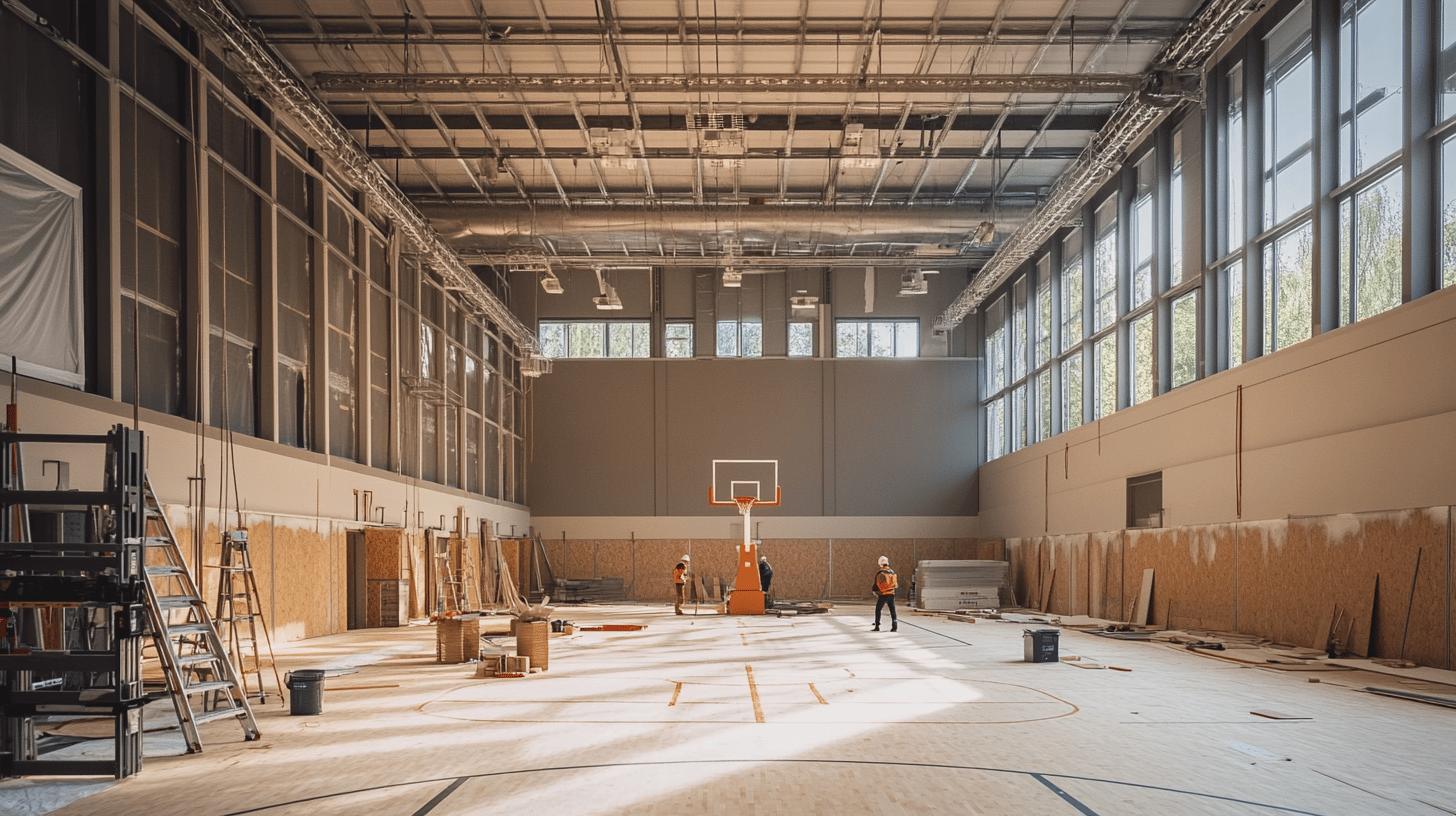Keeping facilities running 24/7 means you can’t really shut down for floor repairs. That’s why picking the right coating and putting it on properly is so important. We’ll look at how to recoat 24/7 facilities without causing too much fuss, focusing on quick fixes and long-lasting results.
Key Takeaways
- Epoxy coatings are good for busy places, but they take a while to dry and can be a bit sensitive to heat.
- Polyaspartic coatings dry super fast, so you can get back to work quickly, and they’re really tough.
- Getting the surface ready is key for any coating to stick properly.
- Temperature and moisture during application really matter for how well the floor coating turns out.
- Regular cleaning helps your coated floor last longer, and some coatings handle things like hot tyres better than others.
.
Understanding Epoxy Coatings for 24/7 Facilities
Composition and Curing Process
So, epoxy coatings, right? They’re basically a two-part system: you’ve got your resin and your hardener. Mix them together, and bam, a chemical reaction starts, turning it into a super tough, protective layer. Getting the mix ratio spot on is key – usually something like 2:1 or 4:1, depending on the product. The higher the volume solids, the better the quality, meaning you get a thicker, longer-lasting finish. Think of it like making a cake; mess up the ingredients, and it all goes wrong.
Benefits for High-Traffic Areas
Epoxy is great for places that see a lot of action. Warehouses, hospitals, even busy retail spaces – epoxy can handle it. It’s strong, durable, and can take a beating from foot traffic, trolleys, and whatever else you throw at it. Plus, it’s easy to clean, which is a massive bonus in places that need to stay hygienic. You can even get easy-to-maintain epoxy driveways if you want something that looks good and lasts.
Epoxy coatings offer a seamless and resilient surface, ideal for environments demanding both durability and cleanliness. Their resistance to chemicals and heavy impacts makes them a go-to choice for industrial and commercial settings.
Here’s a quick rundown of why epoxy works well in high-traffic areas:
- Impact Resistance: Can withstand dropped tools and heavy equipment.
- Chemical Resistance: Protects against spills and leaks.
- Easy Maintenance: Simple to clean and keep hygienic.
.
Limitations and Vulnerabilities
Okay, so epoxy isn’t perfect. It has its weaknesses. For starters, it can be a bit sensitive to temperature and humidity during application. Too cold, and it won’t cure properly. Too humid, and you might get a cloudy finish. Also, it’s not the best when it comes to UV exposure; it can yellow and degrade over time if it’s constantly in direct sunlight. And while it’s tough, it’s not invincible. Heavy impacts and certain chemicals can still damage it. So, you need to think about the specific needs of your facility before you commit. For example, you might need a protective sports lacquer if you’re recoating a sports hall floor.
Exploring Polyaspartic Coating Advantages
Composition and Performance Differences
Polyaspartic coatings are really interesting because they offer a different approach compared to traditional epoxy. They’re known for their unique chemical makeup, which allows them to perform well in a variety of conditions. Unlike some epoxy systems that need very specific mix ratios, polyaspartics often use a simpler 1:1 mix. This reduces the chance of errors during application, which is always a bonus. Molecular flexibility is a key feature, preventing cracks when concrete expands or contracts.
Rapid Curing for Minimal Downtime
One of the biggest advantages of polyaspartic coatings is how quickly they cure. I mean, we’re talking seriously fast! This is a game-changer for facilities that can’t afford long shutdowns.
Here’s a quick comparison:
| Feature | Polyaspartic | Standard Epoxy |
|---|---|---|
| Cure Time | 20-60 minutes | 16-24 hours |
| Foot Traffic | 1 hour | 24+ hours |
| Vehicle Traffic | 24 hours | 72+ hours |
This rapid curing means you can get back to business much faster. For places like hospitals or factories, that’s a massive win. This makes epoxy floor coatings a great alternative.
Enhanced Durability and Resistance
Polyaspartic coatings aren’t just quick; they’re also tough. They’re designed to withstand a lot of wear and tear, making them ideal for high-traffic areas. They also tend to hold their colour longer, especially when exposed to UV light.
Polyaspartic systems often need fewer repairs due to their elastic properties. They’re also more resistant to chemicals, motor oils and industrial solvents, which is a big plus in industrial settings. This makes them a solid choice for places that need a floor that can take a beating.
Application Processes: Mixing, Curing, and Turnaround Times
Flooring projects need accuracy at each step. Mixing and curing times directly affect how quickly the space can be used during installation. Let’s look at how these things affect the schedule and results.
Comparing Mix Ratios and Curing Times
Epoxy systems need exact measurements to cure properly. Typical ratios are from 2:1 to 4:1 base-to-hardener. Mistakes here can lead to sticky or brittle surfaces that peel too soon. Professionals use digital scales and mixing paddles to make sure it’s consistent.
| Factor | Epoxy Coatings | Polyaspartic Coatings |
|---|---|---|
| Mix Ratio | 2:1 to 4:1 | 1:1 |
| Cure Between Coats | 16-24 hours | 20-60 minutes |
| Project Duration | 5-7 days | 1-2 days |
Polyaspartic makes it easier with equal-part mixing. This cuts down on measurement errors and speeds up prep. It fully cures in hours instead of days, so you can use the space sooner. For example, you can use epoxy systems for flooring projects.
Surface Preparation for Optimal Adhesion
Surface prep is still important for both systems. Grinding gets rid of dirt before primer is applied. Epoxy needs 2-3 coats with overnight drying. Polyaspartic lets you finish the job in one day.
Professional Application Techniques
Quick curing needs skilled application. Professionals use special rollers and temperature-controlled tools. These tools stop it from drying too fast, which can cause uneven textures.
Weather affects epoxy more. If humidity is over 85%, it takes longer to cure. Polyaspartic handles moisture better, so it’s good for coastal areas and basements.
Temperature and Environmental Conditions for Installation
Environmental factors can really make or break a floor coating project. You need to think about temperature and moisture levels because they decide if the protective layers will bond properly or fail way too early.
How Weather Impacts Application Success
Epoxy coatings are quite fussy and need strict climate control when you’re putting them down. They like ambient temperatures between 10-32°C to cure properly. If it’s too cold, the chemical reactions slow right down, and you end up with a tacky surface. Too hot, and the curing happens too fast, which can cause bubbles and cracks. It’s a bit of a Goldilocks situation, really.
Humidity and Moisture Considerations
When it comes to moisture, there are a few things to keep in mind:
- Always do concrete slab moisture tests to stop peeling later on.
- Morning dew can delay epoxy applications – nobody wants that.
- If you’re near the coast, the humidity means you’ll need to use rapid-cure formulas.
.
If you’re planning on doing any garage upgrades and using traditional systems, try to do it when the weather is okay. But if it’s urgent, or you live somewhere with mad weather, go for temperature-adaptive solutions. And always, always check the weather forecast before you get the professionals in.
Optimal Operating Ranges for Coatings
Different coatings have different preferences. Here’s a quick look:
| Factor | Epoxy | Polyaspartic |
|---|---|---|
| Operating Range | 10-32°C | -40-40°C |
| Humidity Limit | 85% max | No restriction |
| Moisture Tolerance | Low | High |
Polyaspartic systems are great because they can handle conditions that epoxy just can’t. They bond well in freezing winters and boiling summers. This makes them ideal for places like unheated garages. If you’re looking for overnight flooring services, consider how the temperature might affect the installation.
Longevity and Maintenance for Recoating 24/7 Facilities

Expected Lifespan of Floor Coatings
Okay, so you’ve gone through the hassle of recoating your 24/7 facility. How long can you expect that lovely new floor to last? Well, it depends. Epoxy coatings, if properly maintained, can give you a good 5-10 years. Polyaspartic? You’re looking at potentially 15-20 years, maybe even more. Factors like chemical spills, how much foot traffic there is, and even UV exposure all play a part. Think about recoating the top layer every 5-8 years to keep things fresh and protected. Regular sports floor maintenance is key to extending the life of your investment.
Routine Cleaning and Upkeep
Keeping your coated floors clean isn’t rocket science, but it’s important. Here’s the lowdown:
- Sweep regularly to get rid of any grit or debris that could scratch the surface.
- Mop weekly with a pH-neutral cleaner. Harsh chemicals are a no-no.
- Consider reapplying a wax or sealer annually, especially for epoxy floors, to give them an extra layer of protection.
.
Think of your floor coating like a car. You wouldn’t just drive it and never wash it, would you? Regular cleaning and maintenance will keep it looking good and performing well for years to come.
Addressing Hot Tyre Pickup
Hot tyre pickup is a real pain, especially with epoxy floors. Basically, when your tyres are hot (especially in summer), they can soften the epoxy and leave marks. Polyaspartic coatings are much better at resisting this because they can handle higher temperatures. If you’ve got epoxy, try to avoid parking hot cars on it for extended periods. You might also consider using mats or parking pads to protect the surface. Here’s a quick comparison:
| Feature | Epoxy | Polyaspartic |
|---|---|---|
| Hot Tyre Resistance | Common failure | No marks |
| UV Stability | Moderate | Excellent |
| Expected Lifespan | 5-10 years | 15-20+ years |
| Flake Density | 30-50% coverage | 60-90% coverage |
Addressing Common Concerns for Recoating 24/7 Facilities

Suitability for Cracked Concrete
One of the first questions people ask is, “Can I use this stuff on cracked concrete?” The answer is usually yes, but with caveats. Epoxy and polyaspartic coatings can bridge small cracks, preventing further damage. However, for larger cracks, you’ll need to address them first with a suitable filler or repair compound. Ignoring significant cracks will lead to coating failure down the line. It’s a bit like putting a new coat of paint on a house with a dodgy foundation – it might look good for a while, but the underlying problem will eventually surface. For a sports hall floor, consider the restoration process carefully.
UV Exposure and Colour Stability
UV exposure is a big deal, especially in areas with lots of natural light. Epoxy coatings are known to yellow and fade over time when exposed to UV rays. Polyaspartic coatings, on the other hand, offer much better UV resistance. If colour stability is important, especially for decorative floors, polyaspartic is the way to go. Think about it – you don’t want your fancy new floor looking like it’s aged ten years after only one summer.
Customisation and Decorative Options
Both epoxy and polyaspartic coatings offer a wide range of customisation options. You can choose from a variety of colours, add decorative flakes, or even embed logos. The key difference lies in the application. Polyaspartic coatings often allow for thicker flake layers without curing issues, giving you more creative freedom. With epoxy, you might be limited in the amount of decorative material you can add. Ultimately, the choice depends on your aesthetic preferences and the level of customisation you desire.
It’s worth noting that while both coatings offer customisation, the long-term appearance can vary. Epoxy might show wear and tear more quickly in high-traffic areas, while polyaspartic tends to maintain its look for longer. Consider the overall lifespan and maintenance requirements when making your decision.
Here’s a quick comparison of flake density and UV stability:
| Feature | Epoxy | Polyaspartic |
|---|---|---|
| Flake Density | 30-50% coverage | 60-90% coverage |
| UV Stability | Moderate | Excellent |
Sorting out the floor in places that are always open, like sports halls, can seem tricky. But don’t worry, we’ve got simple ways to make sure your floors look great and last a long time, even with constant use. Want to know more? Pop over to our website to see how we can help with your sports hall flooring needs.
Wrapping It All Up
So, there you have it. Getting your facility floors sorted, especially when you’re open all the time, can seem like a proper headache. But honestly, with a bit of planning and picking the right stuff, it’s totally doable. Think about what your place really needs – is it super busy? Does it get hot? Cold? Knowing that helps you choose between epoxy and polyaspartic. Both are good, but one might just be a better fit for your specific setup. Get the prep right, work with folks who know their stuff, and you’ll have floors that look great and last ages, without shutting down your operations. It’s all about being smart about it, really.
Overnight Flooring Services: Ensure Seamless Facility Operations
Schedule overnight works → Epoxy Floor Coatings
Frequently Asked Questions
What are epoxy coatings made of?
Epoxy coatings are made from two parts: a resin and a hardener. When they mix, they create a tough, plastic-like surface that sticks well to concrete. This makes floors super strong and able to handle lots of foot traffic and heavy stuff.
How do polyaspartic coatings differ from epoxy?
Polyaspartic coatings are a newer type of coating. They’re like an improved version of epoxy. They dry much faster and are even tougher, especially against scratches, chemicals, and hot car tyres.
How long does it take for these floor coatings to dry?
The time it takes depends on the coating. Epoxy floors can take several days to fully dry and be ready for use because each layer needs time to cure. Polyaspartic, however, can be applied and fully dry in just one day, meaning your space can be used again much quicker.
Can these coatings be put on cracked or stained concrete?
Yes, you can! But first, the concrete needs to be properly prepared. This usually means grinding or cleaning the surface to remove any dirt, oil, or old coatings. For cracks, small ones can often be filled by the coating itself, but bigger cracks might need fixing before the coating goes down.
Do these coatings change colour in the sun?
Epoxy can sometimes turn a bit yellow over time, especially if it’s in direct sunlight a lot. Polyaspartic coatings are much better at resisting UV rays, so they keep their original colour for many years, even in sunny spots.
What’s the best way to clean and look after coated floors?
To keep your coated floor looking good, simply sweep it regularly and mop with a gentle, pH-neutral cleaner. Try not to use harsh chemicals or rough scrubbing pads. Polyaspartic floors are especially easy to look after because they naturally resist stains.


